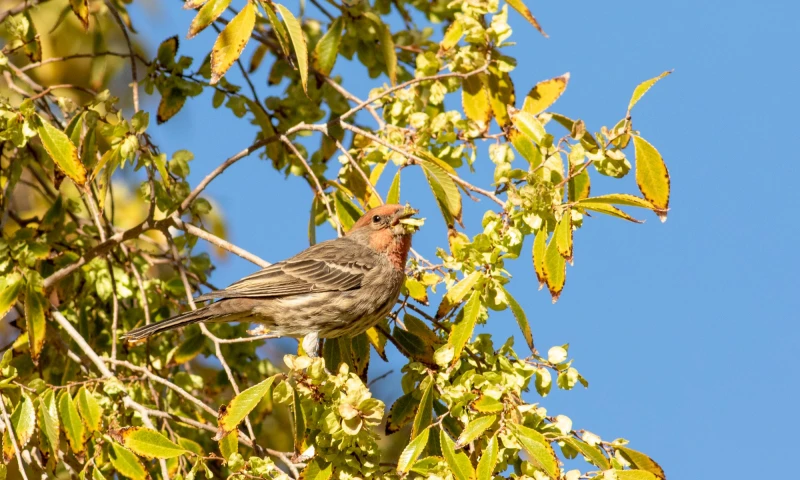By Morrigan DeVito
How much time did you spend outside in January? RRAS invites you to spend 23 minutes outside every day for 2023, whether from your backyard, workplace, or a local park. We’ve created daily prompts to guide your attention in nature every day in February. At the end of each month, we will connect virtually to share our experiences from spending time outdoors.
On Jan. 10 the Mindful Birding Network gathered virtually to share mindful birding stories and listen to guest speakers. The network’s mission is to bring people together to collaborate and share ideas about incorporating mindful birding into their personal and professional lives. Anyone is welcome to join, and one of the guest speakers was Holly Thomas, a scientist who once worked at UC Berkeley studying and teaching physiology. Now, she works as a certified yoga teacher and leads mindful birding outings around Las Cruces, New Mexico for Mesilla Valley Audubon. Tuning in from her home in snowy Soda Springs, CA, Thomas spoke about the physiological effects of mindfulness on brain waves and how mindfulness and meditation can induce more relaxed and focused brain waves like alpha and theta states. She describes mindful birding as,
“[...] bringing that open attention to the moment and warmly greeting whatever shows up (or doesn’t show up) [...] It means tuning in to all my senses — listening deeply, noticing, appreciating.”
Similarly to the RRAS mindful birding events, Thomas invites her mindful birding participants to engage their senses in order to deeply notice the birds.
“I don’t discourage identifying birds, but I don’t think it needs to be the goal either,” she said. “Sometimes identification comes naturally with familiarity or through study [...] naming and moving on quickly can take one away from looking and listening more deeply.”
As a therapeutic tool, mindfulness is defined as bringing attention to the present moment with kindness and without judgment. Being outside is a great way to start practicing mindfulness, as we can redirect our wandering attention to things like birds, trees, rocks, and more. Being in a mindful state allows us to stay present without worrying about the future or ruminating about the past, though of course the mind will naturally wander.
For Thomas, the intersection of nature and wellbeing is of personal interest. Birds, yoga, and meditation have deep roots in her life, from the love of dinosaurs that led her to birds, to her father who taught her how to meditate.
“I wasn’t always sure what I was doing,” she recalled. “Sometimes I would stare at a candle flame while trying to let go of thoughts, or sometimes I would repeat a mantra that he had given me. I think these first experiences got me interested in how one could alter one’s mental state.”
Thomas returned to the meditative aspects of yoga after an injury in her late 30s and became increasingly interested in the restorative aspects of yoga and meditation during her recovery. When she was in graduate school, she attended the Berkeley Zen Center and became interested in inflammation and how the body heals itself, later taking a job at UC Berkeley School of Public Health working on inflammatory peptides. Once she reconnected with yoga, Thomas returned to birding as a hobby when her kids were older. She quickly noticed how birding and meditation activated a similar mental state. This may be in part to how mindfulness reduces stress responses and activates the parasympathetic nervous system, or the “rest and digest” mode that decreases heart rate, slows breathing, and more.
One of the most widely cited studies about the intersection of mindfulness and nature is Kaplan’s attention restoration theory (ART), which describes how our attention is a limited resource that can be rejuvenated through time spent in or looking at nature. This is because nature is immersive and many things, from birds to clouds, can capture our attention as reprieve from daily tasks. He described how mindfulness and meditation amplifies nature’s restorative effects, as your attention has to be aware of nature in order to feel immersed in it. One study from 2019 found that when synthesizing nature exposure and mindfulness practices, nature relieves stress and anxiety because paying attention often alleviates the mind’s wanderings.
It’s natural for the mind to wander and distractions are ever-present. But mindfulness is a tool that you can keep practicing, no matter where you are, how old you are, or what emotional space you’re in. For those unsure how to begin mindful birding or practicing mindfulness in general, Thomas advises,
“Mindfulness can be done anywhere and anytime, so maybe start in a way that seems most accessible, most appealing, and easiest [...] a lot of people these days use apps that remind them or have very short practices that can help get started [...] Tie it together with something you love, that brings you joy. If not birding, maybe an art project, cooking, time with a pet or loved one. If birds don’t do it for you, find something else that does! Life is full of ways to get caught in wonder.”
To find some moments of wonder in nature this February, read the “23 Minutes In Nature” PDF below for guiding prompts.
-1.jpg)
-2.jpg)










